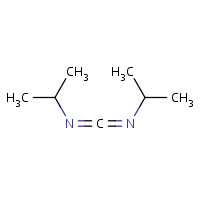1,3-Diisopropylcarbodiimide
Agent Name
1,3-Diisopropylcarbodiimide
CAS Number
693-13-0
Formula
C7-H14-N2
Major Category
Nitrogen Compounds

Synonyms
Diisopropylcarbodiimide; N,N'-Diisopropylcarbodiimide; N,N'-Methanetetraylbis-2-propanamine; 2-Propanamine, N,N'-methanetetraylbis-; Carbodiimide, diisopropyl-; N,N'-Methanetetraylbis(1-methylethylamine); [ChemIDplus] DIPC; DIC; [Merck Index] UN2929
Category
Other Nitrogen Compounds
Description
Colorless liquid; [Merck Index]
Sources/Uses
Used as a reagent in synthetic organic chemistry; [Merck Index] Used as a chemical intermediate and as a stabilizer for Sarin (chemical weapon); [HSDB]
Comments
An irritant; May cause skin and respiratory sensitization; [Merck Index] No evidence of carcinogenicity in dermal studies of mice and rats; Clinical and histological evidence of neurotoxicity observed in male rats; [NTP] A mild skin irritant; Causes cutaneous sensitization, convulsions, coma, lachrymation, ataxia, changes in thymus and kidney weights, weight loss, spermatogenesis, and allergic dermatitis in repeated-dose dermal studies of mice; [RTECS] Reacts with water producing 1,3-diisopropylurea; [HSDB] An irritant that may cause serious eye injury; May cause skin and respiratory sensitization; Highly toxic by inhalation; [Alfa Aesar MSDS]
Biomedical References
Exposure Assessment
Vapor Pressure
9.79 mm Hg
Lethal Concentration
LC50 (rat) = 105 mg/m3/4hr
Explanatory Notes
The Guide in the Emergency Response Guidebook is for "Toxic liquid, flammable, organic, n.o.s."
Adverse Effects
Skin Sensitizer
Yes
Asthma
Yes
Neurotoxin
Other CNS neurotoxin
Diseases, Processes, and Activities Linked to This Agent
Diseases
Occupational diseases associated with exposure to this agent: